| Srl | Item |
| 1 |
ID:
138170
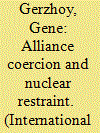

|
|
|
|
|
| Summary/Abstract |
A prominent model of nuclear proliferation posits that a powerful patron state can prevent a weaker ally from proliferating by providing it with security guarantees. The history of West Germany's pursuit of the bomb from 1954 to 1969 suggests that a patron may also need to threaten the client state with military abandonment to convince it not to acquire nuclear weapons.
|
|
|
|
|
|
|
|
|
|
|
|
|
|
|
|
| 2 |
ID:
115366
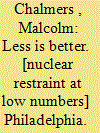

|
|
|
|
|
| Publication |
Philadelphia, RUSI, 2012.
|
| Description |
vi,122p.
|
| Series |
Whitehall Papers Series 78
|
| Standard Number |
9780415814225
|
|
|
|
|
|
|
|
|
|
|
|
Copies: C:1/I:0,R:0,Q:0
Circulation
| Accession# | Call# | Current Location | Status | Policy | Location |
| 056815 | 355.825119/CHA 056815 | Main | On Shelf | General | |
|
|
|
|
| 3 |
ID:
171789
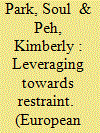

|
|
|
|
|
| Summary/Abstract |
The emergence of new nuclear aspirants has posed a great threat to the post-Cold War global non-proliferation regime. These states have adopted a nuclear hedging strategy that has been deemed both strategically risky and politically difficult to maintain. Yet, hedging has not automatically resulted in nuclearisation. We analyse the conditions under which a nuclear hedger shifts its nuclear policy towards one of restraint. Drawing insights from prospect theory, we argue that a nuclear policy shift occurs when a nuclear hedger gains an asymmetric leverage vis-à-vis its adversary. Specifically, a hedging strategy that is based on loss aversion will only be abandoned when a shift in the nuclear aspirant's reference point occurs during negotiations. To test our theoretical arguments, we conduct an in-depth case study of North Korea's nuclear policies throughout the 1990s and 2000s. The empirical study of the changes in North Korea's negotiating stance during the Agreed Framework negotiations and the Six-Party Talks supports our asymmetric leverage thesis. We conclude with broad policy implications for the non-proliferation regime.
|
|
|
|
|
|
|
|
|
|
|
|
|
|
|
|
| 4 |
ID:
094528
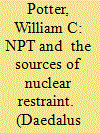

|
|
|
| 5 |
ID:
064290
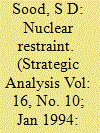

|
|
|
| 6 |
ID:
072880
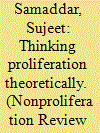

|
|
|
|
|
| Publication |
2005.
|
| Summary/Abstract |
Addressing the challenge of proliferation cannot be successful unless the theoretical underpinnings that rationalize acquisition or renunciation of nuclear weapons are understood. Just as theories explain the phenomenon of conflict and cooperation in international affairs, similarly theories must also explain the phenomenon of nuclear proliferation or restraint. Again, just as sound theory helped policymakers in understanding deterrence politics, a theoretical understanding of the dynamics of proliferation that addresses both the effects of nuclear proliferation and its fundamental causes should benefit nonproliferation policymakers. Long-term idealist goals of a nuclear-weapons-free world need to be theoretically reconciled with realist considerations of the obvious power and prestige that is associated with nuclear weapons. Thinking proliferation theoretically must begin with identifying the stakeholders and spoilers of the contemporary nonproliferation bargain. This article proposes a theory without presenting case studies and reserves policy prescriptions based on these theoretical considerations for a subsequent discussion, keeping in mind Nye's observation that "parsimony suggests that we start with the simple causes, see how much they explain, and go on to more complexity as needed." Some simple causes are stated and the catalysts that spur proliferation reactions are probed in the hopes of provoking "thinking proliferation theoretically."
|
|
|
|
|
|
|
|
|
|
|
|
|
|
|
|
| 7 |
ID:
162678
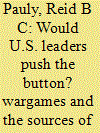

|
|
|
|
|
| Summary/Abstract |
Why since 1945 have nuclear weapons not been used? Political scientists have cited five basic reasons: deterrence, practicality, precedent, reputation, and ethics. Scholars attempting to weight these factors face a dearth of empirical data. Declassified records of political-military wargames played by U.S. policymakers, however, open up new avenues for theory testing. An investigation of the willingness of U.S. “strategic elites”—experts with experience in diplomatic or military strategy—to use nuclear weapons in a sample of twenty-six political-military wargames reveals that elite players were reluctant to cross the nuclear threshold against both nuclear-armed and nonnuclear-armed adversaries. The only uses of nuclear weapons in the sample occurred in two wargames with nuclear adversaries. Players’ arguments for restraint in the wargames invoked reputational aversion: decisionmakers feared the opprobrium they would face if they used nuclear weapons. Wargame records also strongly support the power of deterrence and basic practicality—whether conventional weapons could accomplish the same goals—as reasons for widespread hesitation to use nuclear weapons. Precedent and ethical aversions to using nuclear weapons were less common. Finally, players also demonstrated some conformity to what they thought the president expected of them.
|
|
|
|
|
|
|
|
|
|
|
|
|
|
|
|